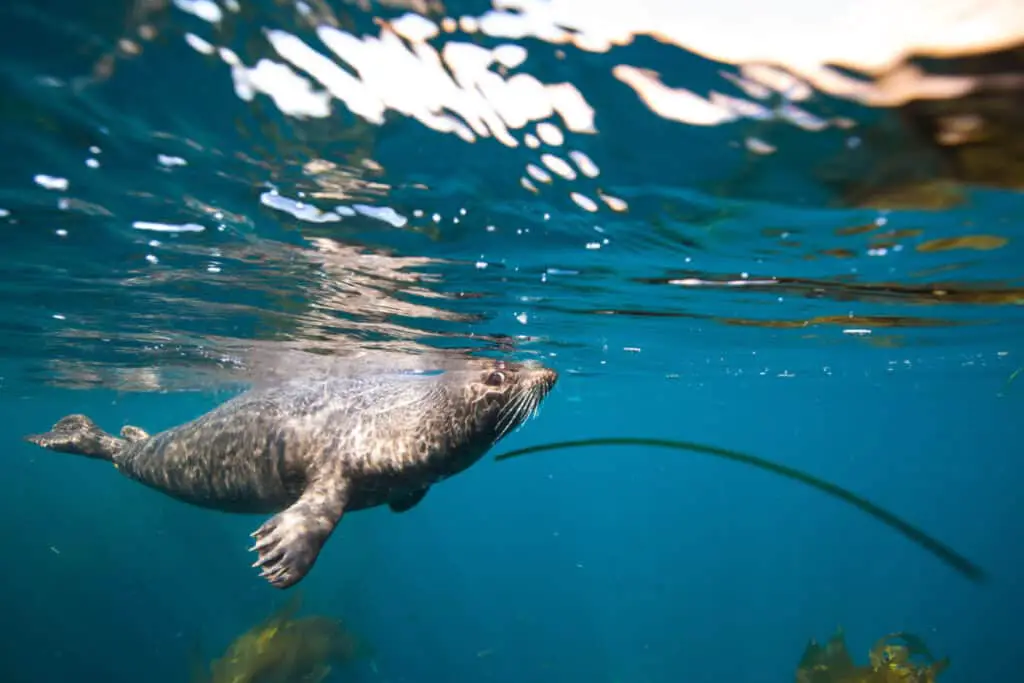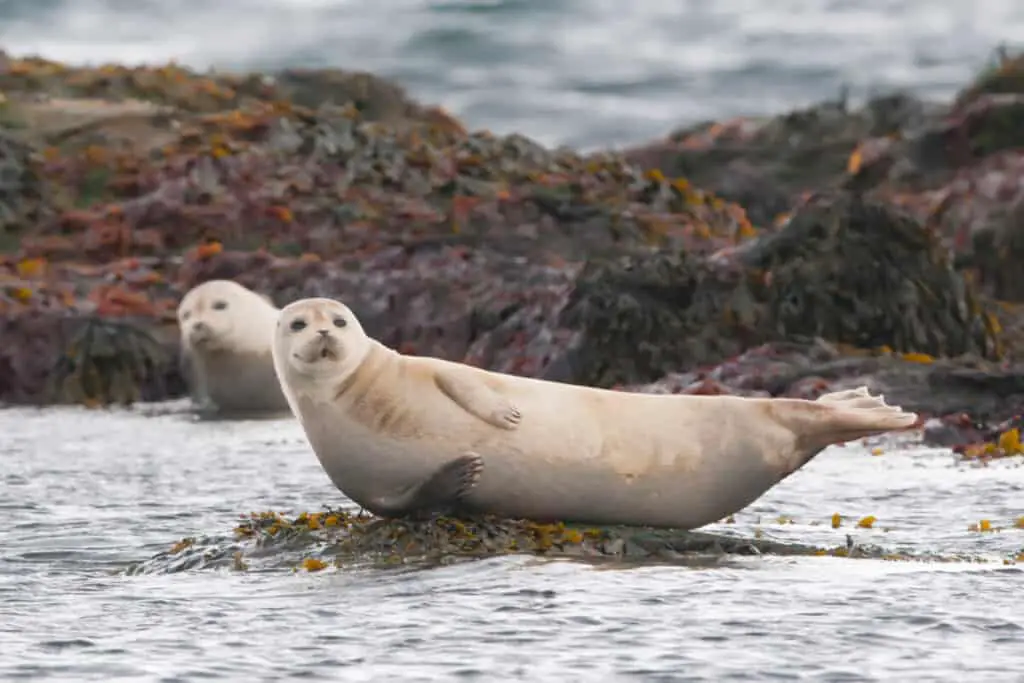Genus Phoca, or the harbor and spotted seal, is a group of marine mammals distributed across various regions in the northern hemisphere. These seals are known for their characteristic spots and distinct physical features that make them easily recognizable from other species. Due to their widespread distribution and ecological significance, these seals have become an important subject of study for marine mammal biologists.
The harbor seal (Phoca vitulina) is one of the most common pinnipeds found along coastal areas of the North Pacific and Atlantic oceans. They are typically found in shallow waters close to shorelines where they rest on rocky outcrops or beaches during low tide.
The spotted seal (Phoca largha), on the other hand, inhabits ice floes and pack ice in sub-Arctic regions such as the Bering Sea and Okhotsk Sea. While both species belong to the same genus, they differ significantly in habitat preference, morphology, physiology, behavior, and life history traits.
In this article, we will explore some of these differences between harbor and spotted seals while providing insight into their biology and ecology.

Physical Characteristics Of Harbor And Spotted Seals
Harbor and spotted seals belong to the genus Phoca, which is widely distributed in coastal waters of the North Pacific and Atlantic Oceans. Both species have similar physical characteristics, with harbor seals being slightly larger than their spotted counterparts. These pinnipeds are sexually dimorphic, with males weighing up to twice as much as females. They have a streamlined body shape that enables them to be efficient swimmers.
Mating habits differ between harbor and spotted seals. Harbor seals breed during late spring or early summer when they haul out onto rocky shores for several days at a time. In contrast, spotted seals mate on pack ice during winter months.
Vocalizations play an important role in reproduction for both species, with males using distinctive calls to attract mates and establish territories. Overall, understanding the physical characteristics and mating behaviors of these two closely related seal species provides insight into their ecology and evolution.
Habitat And Distribution Of Harbor And Spotted Seals
After discussing the physical characteristics of harbor and spotted seals, it is important to understand their habitat and distribution to gain a better understanding of these species.
Both species belong to the genus Phoca, which means they share similar ecological niches. These seals are primarily found in the northern hemisphere, inhabiting coastal areas of the North Pacific Ocean and adjacent seas. They can also be found along the eastern coastlines of Russia, Japan, Alaska, and Canada.
The habitats of harbor and spotted seals vary depending on their life cycle stages. During breeding season, harbor seals prefer rocky shores with easy access to water for swimming while spotted seals migrate long distances from pack ice during mating season to give birth on shorefast ice or land fastened by sea-ice since this provides protection from marine predators such as killer whales.
The distribution patterns of both seal species have been affected by human impact such as hunting for fur trade in the past, oil spills that affect their food resources, entanglement in fishing gear leading to injuries or death causing some populations declines but conservation efforts have helped stabilize populations over time.
Behavioral Differences Between Harbor And Spotted Seals
Harbor and spotted seals have distinct behavioral differences that can be attributed to their differing social structures.
Harbor seals are more solitary animals, preferring to spend time alone or in small groups of up to ten individuals. They communicate through a variety of vocalizations including grunts, growls, and snorts. These calls serve as territorial markers and signals for mating opportunities.
On the other hand, spotted seals are highly social creatures that form large colonies during breeding season. They communicate with each other using a complex system of vocalizations that includes barks, moans, and trills. Their communication is vital for maintaining group cohesion and identifying potential mates within the colony.
This difference in social structure has also led to variations in hunting behavior between the two species. While harbor seals tend to hunt individually by ambushing prey from below, spotted seals often work together in coordinated groups to capture fish and squid.
Overall, it is clear that there are significant behavioral differences between harbor and spotted seals which can be linked directly to their unique social structures. Understanding these distinctions not only enhances our knowledge of marine mammal biology but also contributes to conservation efforts aimed at protecting these fascinating creatures in their natural habitats.
Reproduction And Life History Traits Of Harbor And Spotted Seals
As with most marine mammals, the breeding behavior of harbor and spotted seals is a marvel to behold. Imagine hundreds of seals gathered on the rocky shore, all jostling for position as they emit raucous calls and engage in elaborate courtship rituals. Males compete fiercely for access to females, sometimes engaging in intense physical battles that result in deep wounds and scars. Once a male has secured a mate, he will remain vigilant and protective throughout the duration of her pregnancy.
Reproductive success can vary greatly among individual seals depending on a number of factors including age, health status, environmental conditions, and competition from other individuals. Female seals typically reach sexual maturity around 4-6 years old while males may not become sexually mature until 7-9 years old. Successful breeding requires careful timing and coordination between males and females; once fertilization occurs, gestation lasts approximately 10-11 months before the female gives birth to a single pup.
Overall, understanding the intricacies of reproductive biology is essential for effective management and conservation efforts aimed at protecting these iconic species.
- Breeding Behavior
- Courtship rituals
- Physical battles amongst males
- Protective behavior during pregnancy
- Reproductive Success
- Factors affecting individual success
- Age
- Health status
- Environmental conditions
- Competition from other individuals
- Genetic fitness of offspring

Ecological Significance Of Harbor And Spotted Seals
Having discussed the reproductive and life history traits of harbor and spotted seals, it is important to acknowledge their ecological significance.
These species play a crucial role in maintaining healthy marine ecosystems by serving as both predator and prey. Harbor seals, for example, feed on fish such as herring, cod, and salmon while also being preyed upon by larger predators like killer whales. Furthermore, these seals contribute to nutrient cycling through their excretion and carcasses which can support benthic communities.
Apart from their ecological importance, harbor and spotted seals have cultural and commercial value. Indigenous cultures in Alaska rely on these animals for subsistence hunting as well as for social, spiritual, and ceremonial purposes. In addition to this traditional use, they are also targeted by commercial fishing industries due to their high demand for their meat, oil, fur, and other products.
However, overexploitation has led to declining populations in some areas resulting in conservation efforts aimed at protecting these species from further exploitation. The importance of harbor and spotted seals extends beyond just their ecological function but also includes cultural significance and economic impact on local communities. Therefore, it is crucial that we continue to monitor these populations closely and implement effective management strategies to ensure the sustainable use of these valuable resources.
Conservation Status Of Harbor And Spotted Seals
Harbor and spotted seals belong to the genus Phoca, which is distributed throughout temperate and subarctic regions of the Northern Hemisphere.
These species are considered important in marine ecosystems as they serve as prey for larger predators such as killer whales and polar bears.
However, both harbor and spotted seal populations have experienced declines due to various threats including climate change, habitat loss, predation, hunting, disease outbreaks, contaminants exposure and disturbance from human activities.
To address these conservation concerns, monitoring programs have been established to track population trends and assess the impact of anthropogenic factors on their survival.
For instance, aerial surveys are conducted annually or biennially by government agencies (e.g., National Oceanic Atmospheric Administration) to estimate abundance, distribution and demographic parameters of harbor seals in different regions.
Similarly, satellite telemetry tracking has been used to study movements of individual animals within breeding areas or migratory routes.
Despite these efforts however, there are still challenges that need to be overcome such as insufficient funding for long-term monitoring plans or difficulty in collecting data from remote locations where these species occur.
Therefore, it’s imperative that continued research and management strategies be implemented towards ensuring the persistence of harbor and spotted seals while balancing human needs with ecological sustainability.
Conclusion
The genus Phoca includes two species of seals, the harbor seal (Phoca vitulina) and the spotted seal (Phoca largha).
These marine mammals are widely distributed throughout the Northern Hemisphere and play important ecological roles in their respective habitats.
Harbor seals can be distinguished by their coat coloration which ranges from light to dark gray, while spotted seals have a distinct pattern of black spots on their fur.
Harbor and spotted seals differ in behavior as well.
Spotted seals tend to aggregate in larger groups during breeding season, whereas harbor seals typically breed alone or in small groups.
Both species exhibit similar life history traits, with females giving birth to one pup per year and relying on lactation for nourishment until weaning occurs after about a month.
The conservation status of both species varies depending on location, with some populations experiencing declines due to habitat loss and human disturbance.
As scientists continue to study these fascinating animals, it is important that conservation efforts are implemented to protect them and ensure their continued existence.
In conclusion, what would our world look like without these charismatic creatures?
Would our oceans still thrive with biodiversity?
The importance of understanding and conserving harbor and spotted seals cannot be overstated.
